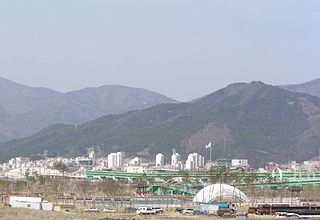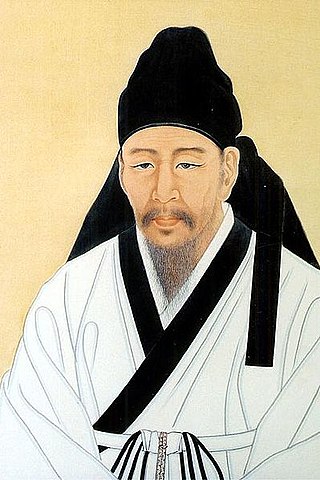
Miryang,formerly also spelled as 推火郡,Milbeol (密伐) and Milseong (密城),is a city in Gyeongsangnam-do Province,South Korea. Its name is originated from the tribal country named Miri midong guk (彌離彌凍國). There are various hypotheses as to the meaning of Miryang,such as Milky Way,Galaxy,dragon's field,Wheat Field and the watery field. Neighboring cities include Changnyeong to the west,Cheongdo to the north,Ulsan to the east,and Yangsan,Gimhae,and Changwon to the south. The city bird is the Korean magpie,the city tree is the pine,and the city flower is the royal azalea.

Yangsan is a city in Gyeongsangnam-do Province,South Korea.

Seowon (Korean: 서원) were the most common educational institutions of Korea during the Joseon Dynasty. They were private institutions,and combined the functions of a Confucian shrine and a Confucian school. In educational terms,the seowon were primarily occupied with preparing young men for the national civil service examinations. In most cases,seowon served only pupils of the aristocratic yangban class. On 6 July 2019,UNESCO recognized a collection of nine seowon as World Heritage Sites.
The name Seowoncheon is also applied to the portion of the Jungnangcheon which separates Seoul from Gyeonggi Province.
Cheontaesan (Korean: 천태산) is a 631-meter-high mountain in Gyeongsangnam-do,South Korea,on the border between Miryang and Yangsan cities. It lies near the southern end of the Yeongnam Alps,and looks south across the Nakdong River to Gimhae. Cheontaesan is connected to Geumosan to its north.
Gachang-myeon is a myeon,or township in rural southeastern Daegu,South Korea. Part of Dalseong County,it is separated from the urban center of Daegu by the ridgelines of Yongjibong and Apsan. These two mountains are separated by the narrow valley of the Sincheon,a tributary of the Nakdong which drains most of the township. The valley of the Sincheon also hosts the only roads that connect Gachang to central Daegu.
Yeongnamnu or Yeongnamru can refer to two pavilions in South Korea:

The Yeongnamnu or Yeongnamru is a pavilion on a cliff overlooking the curve of the Miryang River in central Miryang,Gyeongsangnam-do,South Korea. It dates to the Joseon Dynasty and is one of the central cultural treasures of Miryang. The current structure was built in 1884 according to the design of then-magistrate Yi In-jae. During the Joseon period,this was known as one of the three great pavilions of Korea,together with the Chokseongnu in Jinju and the Pubyŏk pavilion in Pyongyang.
Samnangjin or Samnangjin-eup,is an eup,or town,in Miryang City,Gyeongsangnam-do,South Korea. It is composed of thirteen ri. Samnangjin lies in the southeastern corner of Miryang,bordering Wondong-myeon in Yangsan City.

Kim Chong-jik,often known by his art name Chŏmp'ilchae (점필재),was a leading Korean Neo-Confucian scholar in the early Joseon dynasty. He was born in Miryang in Gyeongsang Province,to a yangban family of the Seonsan Kim clan. He passed the jinsa literary licentiate examination in 1453 and the higher examination in 1459.
Pyochungsa,originally Jungnimsa,is a Korean Buddhist temple of the Jogye Order of Korean Buddhism. It stands on the slopes of Jaeyaksan mountain near Cheonhwangsan in the Yeongnam Alps in Danjang-myeon,northern Miryang,South Korea.
The Chiefdom of Mirimidong was one of the 12 tribes or polities making up the Byeonhan confederation. It is mentioned in the Chinese text Records of the Three Kingdoms,and is generally believed to have been located near the modern-day city of Miryang in Gyeongsangnam-do,South Korea.
Hanam-eup (Korean: 하남읍) is an eup,or large village,in Miryang,Gyeongsangnam-do,South Korea. It stands at the southern tip of Miryang,and looks across the Nakdong River at the northern tips of Gimhae and Changwon.

Samyeongdang (1544–1610),also known by his dharma name Yujeong,was a Korean Buddhist monk during the Joseon era. He is sometimes identified by his art name,Song-un. He was born to a family of the Im clan in Miryang,Gyeongsang Province. After the deaths of his mother in 1558 and his father in 1559,he became a monk at Jikjisa on Hwangaksan in Gimcheon.

Kim Chung-seon,also known by his birth name Sayaka (沙也可) and art name Mohadang (모하당),was a Japanese general who defected to Korea during the Japanese invasion.

Cheonhwangsan (Korean: 청황산) is a mountain in South Korea. It sits on the boundary between the city of Ulsan and the city of Miryang,in the province of Gyeongsangnam-do. Cheonhwangsan has an elevation of 1,189 m (3,901 ft). It is part of the Yeongnam Alps mountain range.
Imcheon Seowon may refer to

Chun Yung-woo served 33 years as a diplomat in the Ministry of Foreign Affairs of South Korea including as the National Security Advisor in the Security Department in the Office of the President of the Republic of Korea.

Busan–Gyeongnam Area,also known as Pusan–Kyŏngnam (PK) is the metropolitan area of Busan,Ulsan,and Gyeongsangnam-do (Gyeongnam) located in southeast South Korea.
Wang Sŏ,known by his title of Marquess Deokyang and later Duke Yangyang,was a Goryeo Royal Prince as the second son of King Sinjong and Queen Seonjeong,also the only younger brother of King Huijong. Through his third son,he would eventually become an ancestor of King Gongyang. In 1204,his father visited his manor,but died there not long after that. In 1211,he was exiled alongside Huijong by Ch'oe Ch'ung-hŏn to Ganghwa Island.











